The ocean is vast and mysterious, it’s no surprise that more than 80% of it is still unexplored.
There’s so much to discover and marvel at–magical marine life, breathtaking sceneries, and the calmness that comes with being around the water.
But there’s also a lot to be scared of. The water conditions could suddenly change, you can get lost at sea, some marine animals are deadly, and more.
That said, the vastness of the ocean is what makes ocean kayaking so exciting and scary at the same time. If you’re looking to take your kayaking adventure to the sea, safety should be your first priority.
So let’s talk about all things pertaining to ocean kayak safety.
ALSO READ: Kayak Safety 101: Everything You Need To Know
Key Takeaways
- If you are planning to go ocean kayaking, make sure you choose the right kayak, paddle, and clothing for the weather and water conditions.
- Always wear a PFD and prepare for immersion by practicing self-rescue skills in case of capsizing or falling into the water.
- Before going out, check the weather forecast, ocean conditions, and tides, and avoid areas with heavy boat traffic.
- Respect marine animals while kayaking in the ocean. Don’t touch, feed, or even approach them.
- It’s also a good idea to kayak with friends or join a kayaking club for more fun and safety.
Can You Kayak in the Ocean?
Yes, you can kayak in the ocean.
People have been kayaking in the ocean ever since the kayak was invented. It’s still one of the most popular recreational activities in many coastal regions all over the world.
But while it’s fun, ocean kayaking can be risky, especially the farther away you go from the shore. The good news is that you can still have a great time kayaking at sea without compromising your safety.
RELATED: What are The Most Common Kayaking Hazards and How to Avoid Them
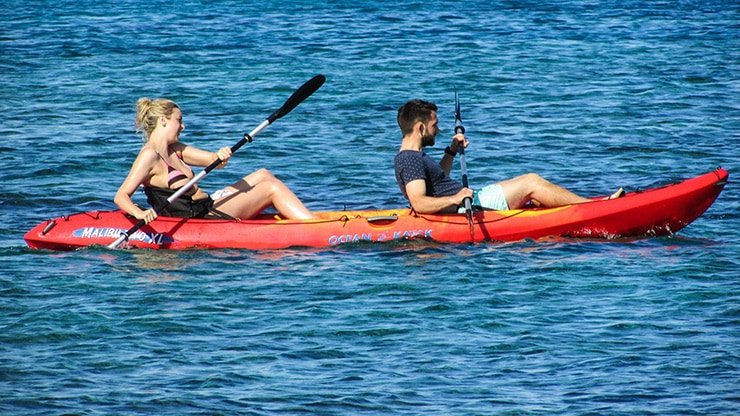
Tips to Safely Kayak in the Ocean
As stated, you can kayak in the ocean, but as with all watersports, safety should be your first priority. Here are tips to help you stay safe while kayaking in the ocean.
Use a Proper Sea Kayak and Paddle
There are different types of kayaks, and not all of them are suited for the ocean. The wrong kayak could easily put you in danger–and your kayaking experience won’t be very fun.
First, kayaks are divided into two broad categories: sit-on-top kayaks and sit-inside kayaks.
A sit-on-top kayak is open and doesn’t have an enclosed cockpit. You sit on top, as the name implies, and your entire body is exposed.
A sit-inside kayak, on the other hand, has an enclosed cockpit where your lower body goes in. So you’re protected from the elements from the waist down. You can stay completely dry with the use of a spray skirt.
Sit-on-top kayaks are more suited for beginner kayakers and recreational ocean tours. Their main benefit is that they’re easy to get back onto if you fall into the kayak. They also have scupper holes so they won’t fill up with water if they capsize.
These kayaks are also great for warmer weather.
The main downside of SOT kayaks for ocean paddling is that you won’t be protected from the elements. So expect to get wet!
Sit-in kayaks will keep water out if you use a spray skirt. They’re the best for ocean kayaking in cold temperatures. However, knowing how to get back into one after capsizing is a skill you have to master.
Kayaks are also divided into categories based on the kayaking activity they were designed for. For serious sea kayaking adventures, ocean kayakers use a proper sea or touring kayak.
These kayaks are long, about 14 to 18 feet, and narrow, less than 30 inches, with a V-shaped hull and pointed ends. This gives them a streamlined shape, allowing them to cut through the water effortlessly.
Ocean kayaks also have dry hatches for storage. Sea kayakers can go on multi-day trips so dry storage is extremely handy.
The right paddle size and design will depend on your body size and paddling technique. It would be best to visit a local outfitter and try different paddles to see what would be best for you.
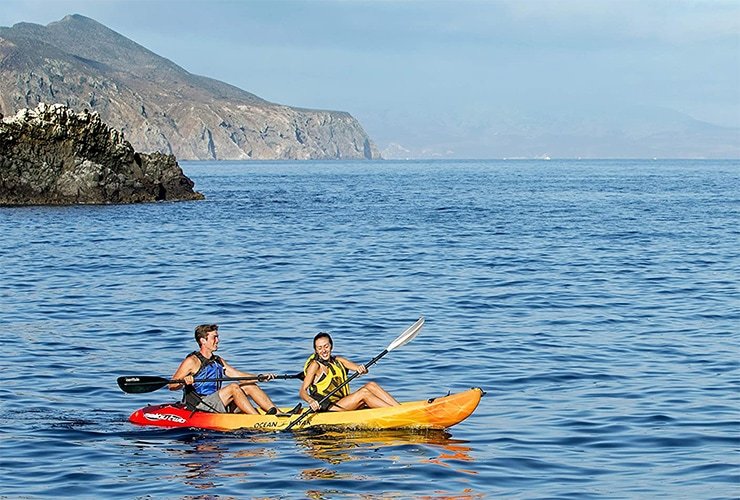
Prepare for Immersion
A good kayaker prepares for immersion because there’s always a chance that you’ll end up in the water.
Preparing for immersion is especially important if you’ll be paddling in cold water. Falling into cold water could lead to cold water shock. You’ll start hyperventilating and gasping for air involuntarily. This is dangerous because you can inhale water.
Dress for the weather and water temperature. If it’s cold, layer up properly to conserve body heat.
What you wear also matters in warm temperatures. Avoid materials like cotton and instead, go for materials that are quick-drying. This way if your kayak flips or you fall into the water you won’t be wet and uncomfortable all day.
Another way of preparing for immersion is by wearing your life jacket. And speaking of life jackets…
Wear Your PFD!
One of the biggest mistakes you can make is to go kayaking in the ocean without your PFD.
A PFD for kayaking or a personal flotation device keeps you afloat when you fall into the water. Even an experienced kayaker needs to have a life jacket while out in the water.
It will offer buoyancy if the water is too cold and you go into cold shock, when you’re trying to save a fellow kayaker, when you’re too tired to swim, or in any other situation that may prove dangerous.
Your PFD must be in good condition and United States Coast Guard-approved.
According to Federal Law, you must have a USCG-approved life jacket onboard for everyone in your vessel. You don’t have to wear it if you’re not aged 13 years and under. But it’s important to note that a PFD can only save you if you wear–and wear it properly.
Not to scare you but drowning is the leading cause of death in kayaking accidents. Even the strongest swimmers can be overpowered by the water. So the next time you go on your sea kayaking adventure, wear your life jacket properly before you get into the water. It could save your life.
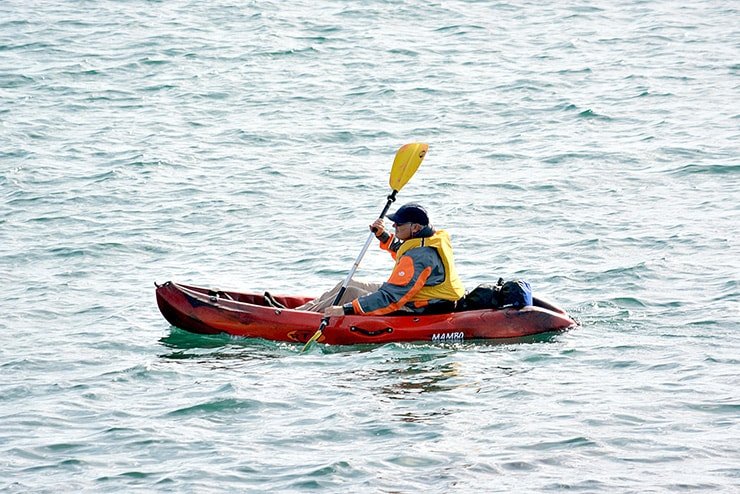
Check the Water and Weather Conditions and Plan Your Trip
Never go into the ocean without knowing what to expect in terms of weather and water conditions.
Check the weather forecast and ocean conditions beforehand so you can plan your trip. Take note of the wind speed as that is a huge indicator of the sea conditions. Don’t forget the wind direction as it can make your ocean kayaking trip fun or frustrating.
ALSO READ: How Much Wind Is Too Much for Kayaking?
I find it better to paddle into the wind when heading out into the ocean. At this time you’re just starting your adventure and you’re full of energy. Then paddle with the wind on your way back to shore. This is when you’re tired and the wind will make your paddle back home easier.
Check the tides, currents, waves, as well as water temperature then plan your trip accordingly.
While out in the ocean, observe the weather patterns and get out of the water if things start to get rough.
Practice Your Self-Rescue Skills
When you are kayaking with friends, they can help you get back into your sea kayak if you capsize. But it’s important to learn self-rescue skills because you’ll need them, sooner or later.
There are times you may want to go on a solo adventure or you may find yourself separated from your buddies. In extreme conditions, you may need to self-rescue so you can help a friend who is stuck.
Take a kayaking class so you can learn how to do a wet exit and reenter your kayak. You should also learn to do the Eskimo roll. You can start by learning in a pool or calm water then move to rougher waters.
You need rough water practice before you go on advanced ocean kayak adventures. I strongly suggest that you don’t practice this alone. Do it with an instructor until it becomes second nature.
Respect Ocean Animals
The ocean is home to a wide range of animals–some friendly, others deadly.
Marine life can be truly magical but part of water safety is knowing how to properly interact with wildlife.
Avoid approaching and touching marine animals. This is for both your safety and theirs. Some animals like sharks can be dangerous and may mistake you for food. You don’t want to provoke them into attacking you.
Getting too close to some of the animals may also cause them to change their behavior patterns. And that’s not good for them in the long run.
If you’re lucky enough to see marine life while kayaking in the ocean, keep your distance. Observe and take photos without getting any closer to them. In the case of dangerous animals like sharks, you’ll want to paddle away fast but calmly.
Remember that the ocean is the animal’s home. You’re the visitor. Observe the basic rules of interacting with wildlife and don’t disturb them or disrupt their routine.
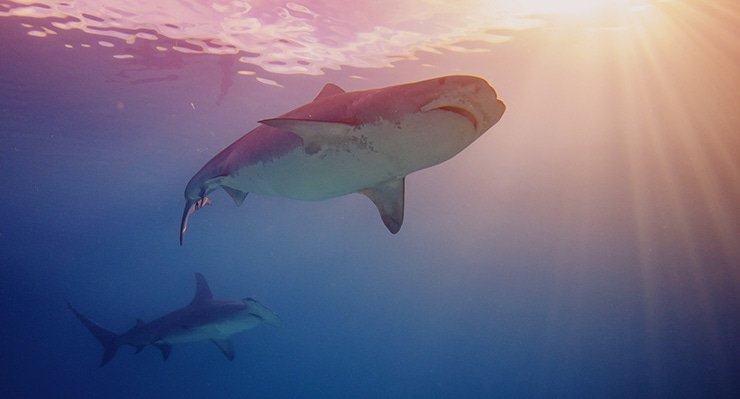
Beware of Other Water Vessels
You most likely won’t be the only one in the ocean. So you’ll need to learn how to share the water with other people and vessels.
You should especially be careful when kayaking in an area with a lot of motorized boat traffic. The last thing you want is a big boat ramming into your kayak.
Against the vast backdrop of the ocean, kayaks appear small and are not easy to spot. Sometimes the boater may spot you when it’s too late. Big boats can’t turn fast and this will mean trouble.
The best solution would be to avoid kayaking in areas with a lot of boats and jet skis. Also, try to wear bright colors to make yourself visible. When kayaking at night, make use of reflective clothing and kayak lights so other water users can spot you from afar.
Go with a Group of Friends
Lastly, kayaking in the ocean is much safer with friends.
Solo kayaking trips are peaceful but going out with other people is safer. This is true for beginners as well as experienced kayakers.
The ocean and the weather are both unpredictable and a lot can happen. Going with friends means that you have people to help you when you can’t help yourself. It’s also easier to stay calm when you’re in trouble, knowing that you’re not alone.
If you don’t have any kayaking buddies, consider joining kayaking clubs in your area to meet other sea kayakers and join them in their ocean kayaking adventures.
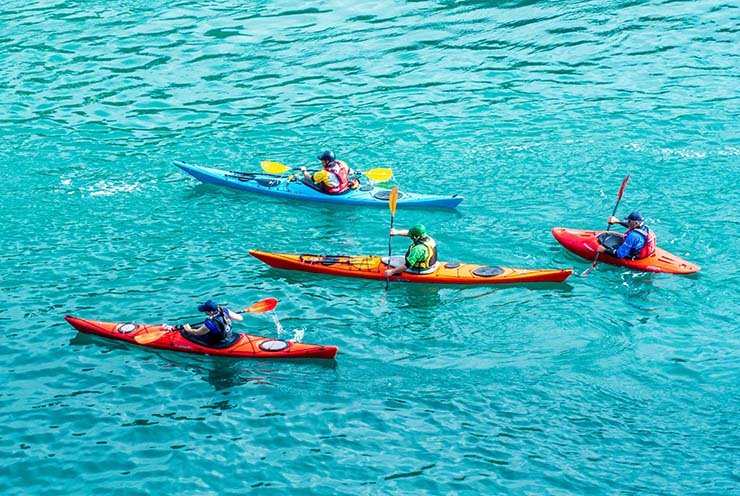
Frequently Asked Questions About Ocean Kayak Safety
Is Sea Kayaking Safe?
Yes, sea kayaking is generally safe but not without it’s risks. There are safety precautions that you need to take seriously. Always wear your PFD and prepare for immersion. Take a kayaking lesson and learn all the useful techniques including self-rescue skills.
Can You Stand Up in an Ocean Kayak?
A proper ocean kayak is long and narrow, usually less than 30 inches. You will find it too tippy if you try to stand on it while in the water.
How Do You Handle Waves in a Kayak?
Don’t position your kayak parallel to the wave because the wave can easily tip you over that way. Instead, face waves head-on with your bow pointing straight at the wave.
Try to keep your paddle blade in the water while going through the wave. This gives you some degree of control so the wave doesn’t overpower you.
You might also want to keep the paddle shaft away from your face. The wave can crash and cause the shaft to hit your face.
What Do You Need to Kayak in the Ocean?
To kayak in the ocean, you’ll need the right equipment. This can include, but is not limited to, the following:
- Sea kayak
- Paddle
- Spare paddle
- Life jacket
- Bilge pump (to pump out water from the cockpit if you capsize)
- Spray skirt
- Drinking water and snacks
- Marine radio
- First aid kit
- Sunscreen
- Appropriate clothing for the weather
Conclusion
Ocean kayaking is a thrilling activity, no doubt. But it’s also a bit riskier than most of the other kayaking disciplines.
That doesn’t mean you can’t still enjoy kayaking adventures in the ocean, safely. First, make sure you get the right kayak depending on the nature of your trip. Always wear your life jacket properly and prepare for immersion.
I recommend taking kayaking lessons so you can learn how to self-rescue and other key kayaking skills. Check the weather forecast before going out and respect marine animals while in the ocean.
Finally, sea kayaking is safer and more fun with friends. So don’t hesitate to connect with other sea kayakers!

